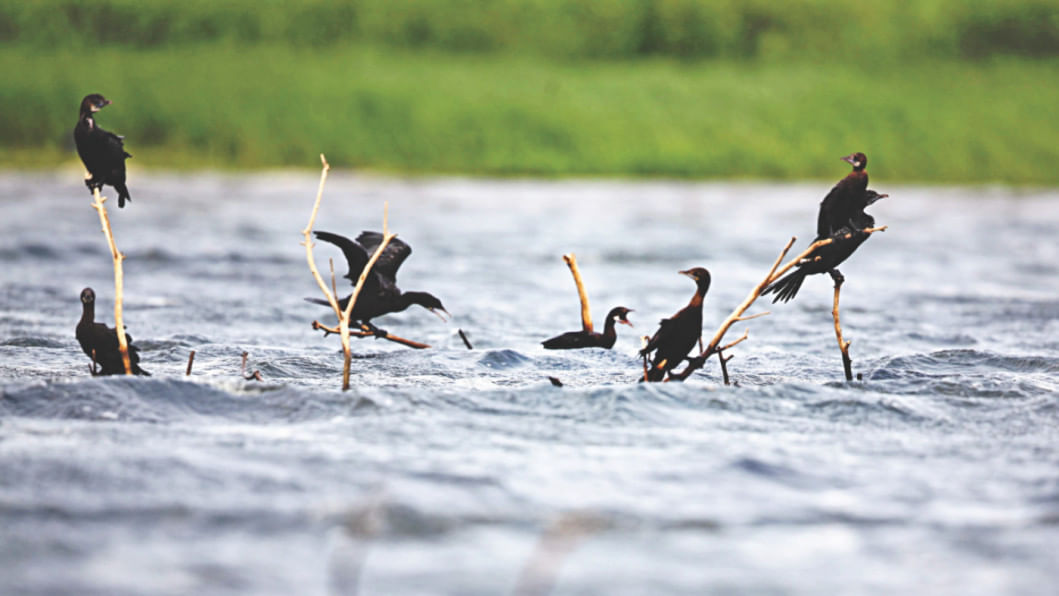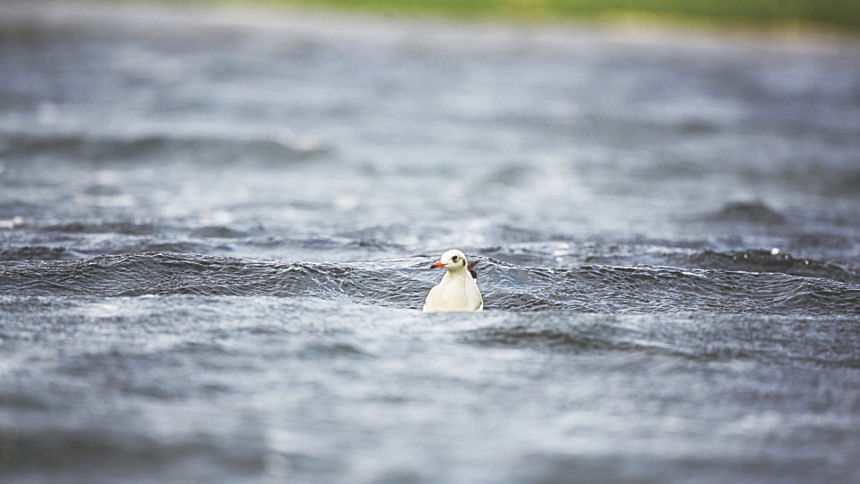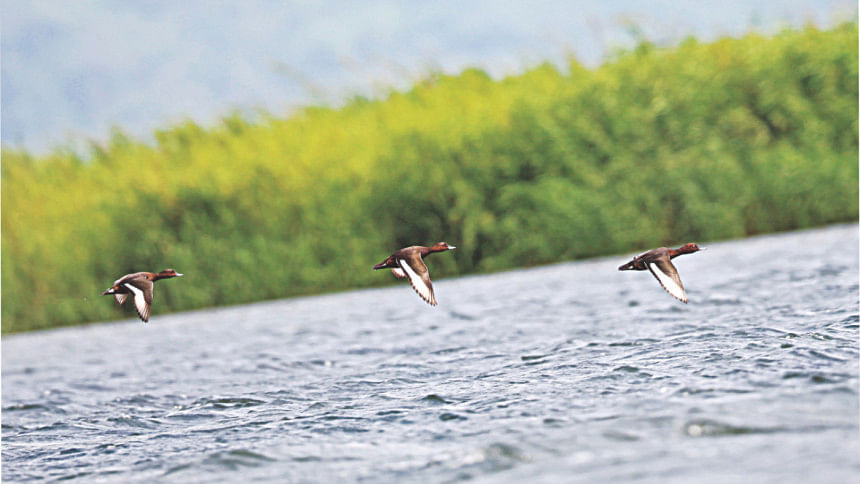The vibrant Tanguar Haor

A chill in the third week of April is unusual in the Tanguar Haor under Taherpur Upazila in Sunamganj. But because of El Niño and many other erratic weather patterns caused by global warming, greenhouse gas emission and sea level rise have made the world climate rather unstable.
So I did not expect a stormy weather on the morning of 20th April when I boarded a canoe, 12 feet by 3, which can support at least three heavy persons like me. As the whole of the Tanguar Haor has been imprisoned by embankments to protect the paddy crops from flash floods and excessive unseasonal rains, our canoe had to be dragged over one of the embankments at Golabari and then led into the haor proper.
I had normal full-sleeve, field wear but as we entered the lake proper, the weather turned inclement. The wind that went wild and formed lots of waves in the water made us shiver and the canoe wobbly. When I was putting on additional layers of clothes to prevent myself from catching cold, the boatman, a lad from the local village, possibly had no clue as to how to ride through the waves. I had to take over and direct the boat facing the wind and the waves at the same time, leading the boat to a shelter of reeds and other water loving shrubby plants not more than 200 metres from us.
When we were struggling to avoid the wavy centre of the haor and were rather fearful of dropping the cameras and other gadgets into the water, we were amazed to see a tight flock of over 1,000 ducks of various sizes, shapes and colours were virtually dancing in sync with the swings of the waves.

I wasted no time to take photographs of the flock from one end to the other so that I can identify them later when we reach our main boat safely. Possibly realizing our precarious positions on a small boat, the flock decided to take off. This gave me a chance to take some running shots although the sky was overcast and we were expecting the rain any time.
The ducks landed just a few hundred metres away in the direction of the boat. By that time the boat had reached within few metres of an island with reeds and thickets. As our canoe touched the island, a pair of Pati Hansh (Spot-billed Ducks) flew off producing quite a ruckus like the domesticated ducks. They too landed not far from us. I had a kind of feeling that the pair had a nest on the island. As we had no intention of disturbing any animal, we left the area and kept moving.
In one bend of the haor, there were over two dozen Kalim or Kaim (Purple Swamphen) that earlier used to be called Purple Moorhen. These birds are also possibly breeding because a large number of them visit the haor during the winter migration time when a few hundreds that stay back are thought to be permanent residents of the Tanguar Haor where they breed. They were all busy with their morning feeding bouts, trying to dry their wings that got wet from last night's heavy rain with bolts of thunder and hail storms.
We came across flocks of Little Cormorant or Paankauri. They were too busy gathering fish swimming underwater when almost all ducks were dabbling to fetch food from under the surface of the water. We did not see any diving duck at that time.
When deeply engaged in taking snaps of ducks, almost suddenly all birds scurried for covers. Before I could guess what happened, I saw an immature Kura or Pallas's or Ring-tailed Fish Eagle flying past our canoe. I realised the reason behind all the commotion because it feeds entirely on other birds of the haor. Kura is a winter-breeding migrant and at least 4 pairs are known to breed around the Tanguar Haor every year. Once the breeding is over, both the young and the old depart for high hills, possibly in the neighbouring territories of India and Myanmar. Sometimes one or two immature ones fail to keep pace with their parents and keep the Tanguar Haor as its summer home. Therefore, it is not unlikely to see stray Kuras in this and other haors of the Greater Sylhet District
Several Shankhachil or Brahminy Kite were busy sky-diving and swooping on unsuspected fishes that surfaced to some oxygen from the open air. Some were also contented with the dead fish floating in the vast stretches of the haor water.

Most ducks and larger birds even did not take notice of the Shankhachils as they are only fish-eaters.
However, Golabari villagers complained that Shankhachils sometimes snatch their hens and ducklings. But they seemed to be living with it and did not show much anger towards this and other birds of prey. Luckily the Kuras, which breed permanently on a tree in this village, are not known to attack ducks kept by the villagers.
After nearly an hour of boat ride through rough water, we reached much calmer beels laden with Trapa or Singra plants, water lilies and lotuses.
Most welcoming were dozens of Gangchil or Whiskered Tern that are known to breed along the banks of the haor. There also appeared a few Chhoto Gangchil or Little Tern that fly more like a butterfly than a bird.
As we were approaching low water ranges of the haor, we started coming across herons and egrets giving company to buffalos grazing and wallowing in muddy knee-deep water. We found all three white egrets, the Great White, Intermediate and Little Egrets as well as the Kanibok or Pond Heron which is abundant throughout the country. Jungle Mynas and Black Drongos never miss an opportunity to ride on the backs of the grazing animals and pick up insects that disturb them. Once in a while crows may join the foray.
Time was ticking out for us to move towards the shore as we were supposed to have our meal in the new boat house built by a local enthusiast Bellal who spent over 6 lakh takas over this which is equipped with solar power for running laptop and charging all cell phones.
It had high commodes with water coming out of a plastic drum placed at a high stool nearby.
My short sojourn proved that the Tanguar haor is vibrant in all seasons whether it is winter or not.

 For all latest news, follow The Daily Star's Google News channel.
For all latest news, follow The Daily Star's Google News channel. 



Comments